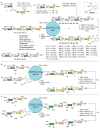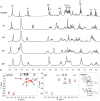Expeditious chemical synthesis of xylomannans disproves the proposed antifreeze activities
- PMID: 39315280
- PMCID: PMC11418650
- DOI: 10.1093/nsr/nwae296
Expeditious chemical synthesis of xylomannans disproves the proposed antifreeze activities
Abstract
Cold-adapted species are able to generate cryoprotective proteins and glycoproteins to prevent freezing damage. The [→4)-β-D-Manp-(1→4)-β-D-Xylp-(1→] n xylomannan from the Alaska beetle Upis ceramboides was disclosed by Walters and co-workers in 2009 as the first glycan-based antifreeze agent, which was later reported to be found in diverse taxa. Here, we report the rapid synthesis of four types of xylomannans, including the proposed antifreeze xylomannan up to a 64-mer (Type I), the regioisomeric [→3)-β-D-Manp-(1→4)-β-D-Xylp-(1→] n 16-mer (Type II), the diastereomeric [→4)-β-L-Manp-(1→4)-β-D-Xylp-(1→] n 16-mer (Type III) and the block-wise [→4)-β-D-Manp-(1→] m [→4)-β-D-Xylp-(1→] n 32-mer (Type IV), by employing a strategic iterative exponential glycan growth (IEGG) process. The nuclear magnetic resonance spectral data of the alleged natural xylomannan are in accordance only to those of the block-wise Type IV glycan and none of these synthetic xylomannans has been found to be capable of inducing thermal hysteresis. These results disprove the previous reports about the natural occurrence of antifreeze xylomannans.
Keywords: antifreeze; glycosylation; polysaccharide; total synthesis; xylomannan.
© The Author(s) 2024. Published by Oxford University Press on behalf of China Science Publishing & Media Ltd.
Figures




Similar articles
-
Synthesis and structural verification of the xylomannan antifreeze substance from the freeze-tolerant Alaskan beetle Upis ceramboides.J Org Chem. 2011 Nov 4;76(21):8611-20. doi: 10.1021/jo201780e. Epub 2011 Oct 7. J Org Chem. 2011. PMID: 21955117 Free PMC article.
-
Synthetic study and structural analysis of the antifreeze agent xylomannan from Upis ceramboides.J Am Chem Soc. 2011 Dec 7;133(48):19524-35. doi: 10.1021/ja208528c. Epub 2011 Nov 14. J Am Chem Soc. 2011. PMID: 22029271
-
A nonprotein thermal hysteresis-producing xylomannan antifreeze in the freeze-tolerant Alaskan beetle Upis ceramboides.Proc Natl Acad Sci U S A. 2009 Dec 1;106(48):20210-5. doi: 10.1073/pnas.0909872106. Epub 2009 Nov 23. Proc Natl Acad Sci U S A. 2009. PMID: 19934038 Free PMC article.
-
Animal ice-binding (antifreeze) proteins and glycolipids: an overview with emphasis on physiological function.J Exp Biol. 2015 Jun;218(Pt 12):1846-55. doi: 10.1242/jeb.116905. J Exp Biol. 2015. PMID: 26085662 Review.
-
The mechanism by which fish antifreeze proteins cause thermal hysteresis.Cryobiology. 2005 Dec;51(3):262-80. doi: 10.1016/j.cryobiol.2005.07.007. Epub 2005 Sep 2. Cryobiology. 2005. PMID: 16140290 Review.
References
LinkOut - more resources
Full Text Sources
Miscellaneous
